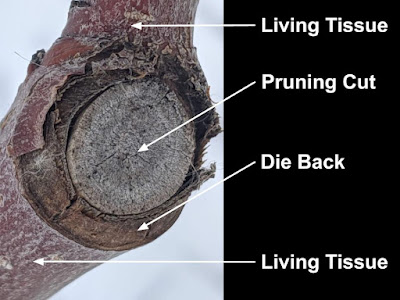What Happens to Pruning Cuts in the Winter?
Last week we discussed the pros and cons of pruning fruit trees in the winter. In that article we discussed what happens to pruning cuts when they are exposed to the cold, dry winter air. Last week I also returned to a small orchard to do some annual pruning. This orchard is located in a USDA Hardiness Zone 6b. It was a great time to inspect how the trees responded to winter pruning over the last several years
I'm happy to report that the trees have never looked better, but I was able to identify some die back from the larger pruning cuts.
As you can see, the cold winter weather caused 1 or 2 centimetres of the cambium and bark tissue to die back. Will these pruning cuts ever grow back and seal up? Yes! The tree will just need to grow an extra 1 or 2 centimetres before the pruning cut is completely sealed off. Let's look at a few more images.
What can we learn from what happens to pruning cuts in the winter? Pruning cuts will die back, but your trees will not die. Because these pruning cuts take longer to seal up, they are more susceptible to heart wood rot and other fruit tree diseases, but that is why it is so important that pruning occurs every year. Annual pruning will help you avoid having to make large cuts on your fruit trees.







Comments
Post a Comment